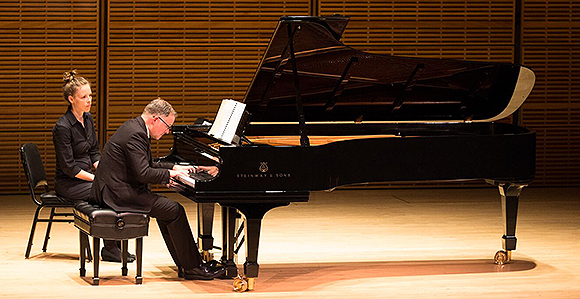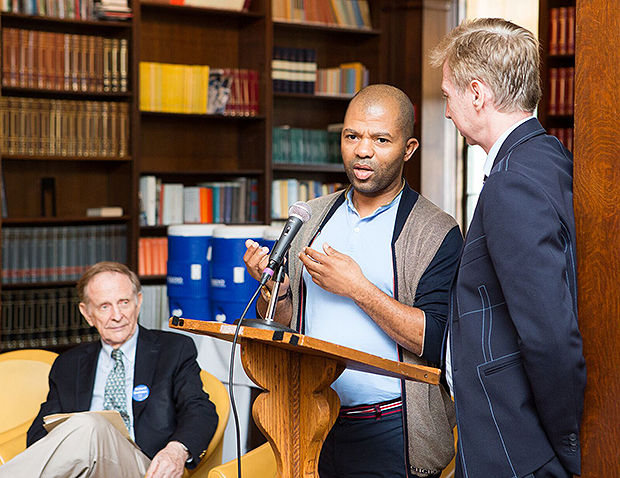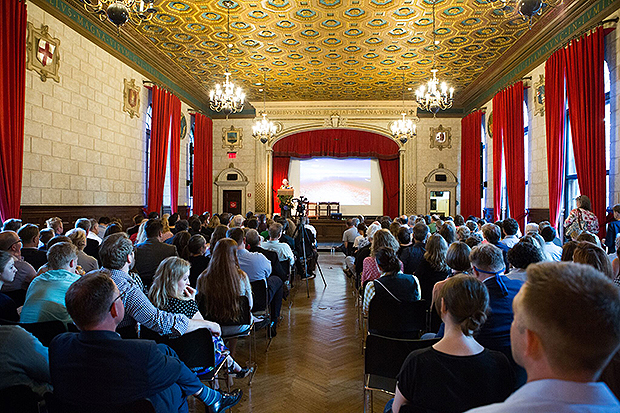Mormon Arts Festival Highlights Artistic Work and Stories of People Around the World
Contributed By Morgan Jones, Church News staff writer

Scott Holden performs at New York City’s Carnegie Hall June 29 during the Mormon Arts Festival. Photo by Rebecca Reed.
Article Highlights
- Mormon Arts Festival brings to light the work of any artist who is a member of the Church or has been touched by the culture of the gospel.
“It doesn’t have to be evangelizing for us to get the message of who we are out there. Sometimes an effective way is to just show our best work—maybe that’s enough.” —Glen Nelson, cofounder of the Mormon Arts Festival
Elder Bruce R. McConkie of the Quorum of the Twelve Apostles had a brother who at one point seemed more poised to become famous than the well-known Apostle.
James W. McConkie was a composer who received his PhD from Columbia and studied in Paris with some of the most important classical music teachers of the 20th century.
However, in the early 1950s before the public availability of a polio vaccine, all three of James McConkie’s children contracted the deadly illness. Doctors warned that the children were extremely contagious and should not be touched, but as James watched his children suffer, he kissed one of them on the forehead and eventually contracted the illness. Although each of the children survived, James McConkie passed away at 32 years old.
His unexpected death left his family heartbroken and grieving. Many of his compositions and correspondences were put in a box and there remained for decades.
“It was an unspeakable tragedy,” said Judith McConkie, daughter-in-law to James McConkie. “Through all these years, people could not bear to deal with the loss.”
Last month, James W. McConkie’s work was performed at New York City’s Carnegie Hall as part of the Mormon Arts Festival. According to Judith McConkie, bringing his music to light has brought solace to the family as they have been able to honor their loved one’s work.
“It became something that everyone in the family could respond to and be grateful for because these are works of faith and joy [by] a remarkable mind,” she said. “It opened up the box and let us talk.”

One of the Mormon Art Festival’s founders—historian, educator, and author Richard Bushman—presents at an opening night event for donors on June 28.
Poet, writer, and publisher Glen Nelson describes the role he and well-known historian, educator, and author Richard Bushman have as founders of the Mormon Arts Festival as half-archeologists and half-spies.
“The Church is so good at the things that they do, but sometimes it’s really difficult to find people who fly under the radar,” he said.
The Mormon Arts Festival is advised by a board that includes, besides Bushman and Nelson, Dave Checketts and Sister Harriet Uchtdorf, wife of Elder Dieter F. Uchtdorf of the Quorum of the Twelve Apostles.
And the festival’s mission is to bring to light the work of any artist who is a member of the Church or has been touched by the culture of the gospel.
“What this brings to the floor is that we have a church, which is very powerful and very effective, but beyond that, we have a culture,” Bushman said. “We are a people, not just a church—almost an ethnic group—and that ethnic group has a culture, which is expressed through art to a large extent.”
They have found that for members of the Church, creating these works is often a spiritual experience, regardless of whether the art is religious in nature.
“Their concert works are really deeply meaningful to them and spiritual. They don’t distinguish between sacred and secular,” Nelson said. “For them, they’re tapping into inspiration from these sources that are heavenly, so a sonata is as meaningful spiritually to them as a hymn.”
Bushman explains that he believes that as Church members become familiar with this art, it “heightens our sense of who we are.” But even more than that, it is the hope of Bushman and Nelson that others will come to understand Latter-day Saints as their art is more widely shared.
“We have to realize that it’s not enough to do art that looks good in our chapels and in our temples,” Bushman said. “We need an art that speaks to the broader world. We’ve never been a people that turns in. We’ve always turned out.”
Their efforts are paying off. This year’s festival even attracted the attention of The New York Times’ chief classical music critic Anthony Tommasini, who requested tickets to the performance at Carnegie Hall.
“What that indicated to me was this is news, this is quality, and it’s not just an insular, ‘Let’s put on a show for ourselves,’” Nelson said, adding that Tommasini ultimately fell ill and was unable to attend but sent his regards. “So we just sent him a CD. … But that’s a really interesting lesson for us. It doesn’t have to be evangelizing for us to get the message of who we are out there. Sometimes an effective way is to just show our best work—maybe that’s enough.”
Artists and composers flew in from Angola, Kuwait, the Dominican Republic, and all across the United States to attend this year’s festival, and in the end, Bushman says he believes everyone there felt “they had really been in on something fabulous.”

Hildebrando de Melo, an LDS artist from Angola, speaks at the donor event on opening night of the Mormon Arts Festival June 28. Photo by Rebecca Reed.
In the days leading up to the festival, an 80-inch high poster was displayed outside Carnegie Hall advertising the performance of Scott Holden, a BYU professor and pianist who performed the work of 14 different composers, including James W. McConkie. McConkie’s family in attendance included his three children—James W. McConkie II, Kathleen McConkie Collinwood, and Michele McConkie Erekson. Holden played a sonatina written by the late composer.
“When [Holden] finished, he took the applause, took his bows, and then he said, ‘I’d like the children to stand and receive the applause that [James W. McConkie] should have,’” said Judith McConkie. “It was wonderful.”
It was a life-changing moment for the family, many of whom have taken after their ancestor and have since become accomplished musicians. The significance of the moment wasn’t lost on the audience, either.
“It was almost a redemptive act,” Nelson said, becoming choked up. “Here’s somebody whose work was unjustifiably lost.”
Holden added that months of practice paid off in the performance.
“Walking onstage, performing, sometimes feels like you are in survival mode hoping to get through it relatively unscarred,” Holden said. “And sometimes it feels just magical, and [performing at the festival] just was really magical.”
When the lights went up in the performance hall, which holds 599 people and was nearly filled to capacity, Nelson said it was as if no one wanted to go home. Attendees stood outside the hall visiting with one another under the lights of Carnegie Hall and the poster that read “Mormon Arts Festival.”
“It was, for us and the arts community, sort of like when the Church took over Times Square with all of the ‘I’m a Mormon’ ads,” Nelson said. “It felt like an arrival.”
While the long-term goal of the festival is to eventually have a permanent exhibit in New York City, Nelson says he does not focus on that. He instead focuses on bringing to light the work and stories of people around the world.
“A culture is a powerful thing, and the people in that culture identify with the artifacts of the culture,” Nelson said. “So if you’re an American, for example, famous American movies or plays or books or paintings end up becoming part of your identity, so for us to not know our own cultural history, it’s just a missed opportunity.”
The Sunday after the festival ended, Nelson recalls being approached by an African American man at church whose family had traveled to attend the conference.
The man grabbed both of Nelson’s shoulders, looked into eyes, and, in an effort to express gratitude for displaying the art of an LDS artist from Africa, said, “Thank you, thank you, thank you.”

Author Laurel Thatcher Ulrich presents at the opening night celebration of the Mormon Arts Festival June 28 at the Italian Academy at Columbia University. Photo by Rebecca Reed.
